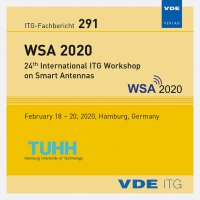Indoor Measurements with Commercial 60 GHz WLAN Components
Conference: WSA 2020 - 24th International ITG Workshop on Smart Antennas
02/18/2020 - 02/20/2020 at Hamburg, Germany
Proceedings: WSA 2020
Pages: 5Language: englishTyp: PDF
Personal VDE Members are entitled to a 10% discount on this title
Authors:
Hoffmann, Dennis; Fellhauer, Felix; Arnold, Maximilian; ten Brink, Stephan (Institute of Telecommunications, University of Stuttgart, Pfaffenwaldring 47, 70569 Stuttgart, Germany)
Abstract:
The first wave of WLAN products compatible to the IEEE 802.11ad standard promise to enable extreme wireless throughput of up to 1 Gb=s, making the 60GHz spectrum available for consumers. Concerning applicability of those devices, questions on actual physical layer performance in real-world scenarios arise. Among others, maximum achievable throughput, coverage, and standard compatibility can be examined. In this paper, we present measurement results investigating physicallayer performance measures of off-the-shelf 60GHz wireless LAN (WLAN) hardware. In an indoor environment at an intersection of corridors, we consider a measurement scenario consisting of three access-points and a mobile station mounted on top of an automated guided vehicle (AGV), which allows to perform automated measurements within a predefined area. We verify our setup by comparing actual measurements of station (RSSI) and round-trip time (RTT) (i.e. distance between devices) with reference data. Results show, that coverage even under challenging non line-of-sight (NLOS) conditions can be achieved in the investigated scenario. The highest modulation and coding scheme (MCS), corresponding to a physical layer (PHY) bit-rate of 2310Mb=s, can be achieved in approx. 80% of locations. Measurement results of RTT accuracy, show that timing measurements are prone to misalignment of devices, but can achieve an accuracy with a standard deviation below 20mm, when aligned properly. Further, user localization based on trilateration using three access-points can achieve accuracy below 1m.


